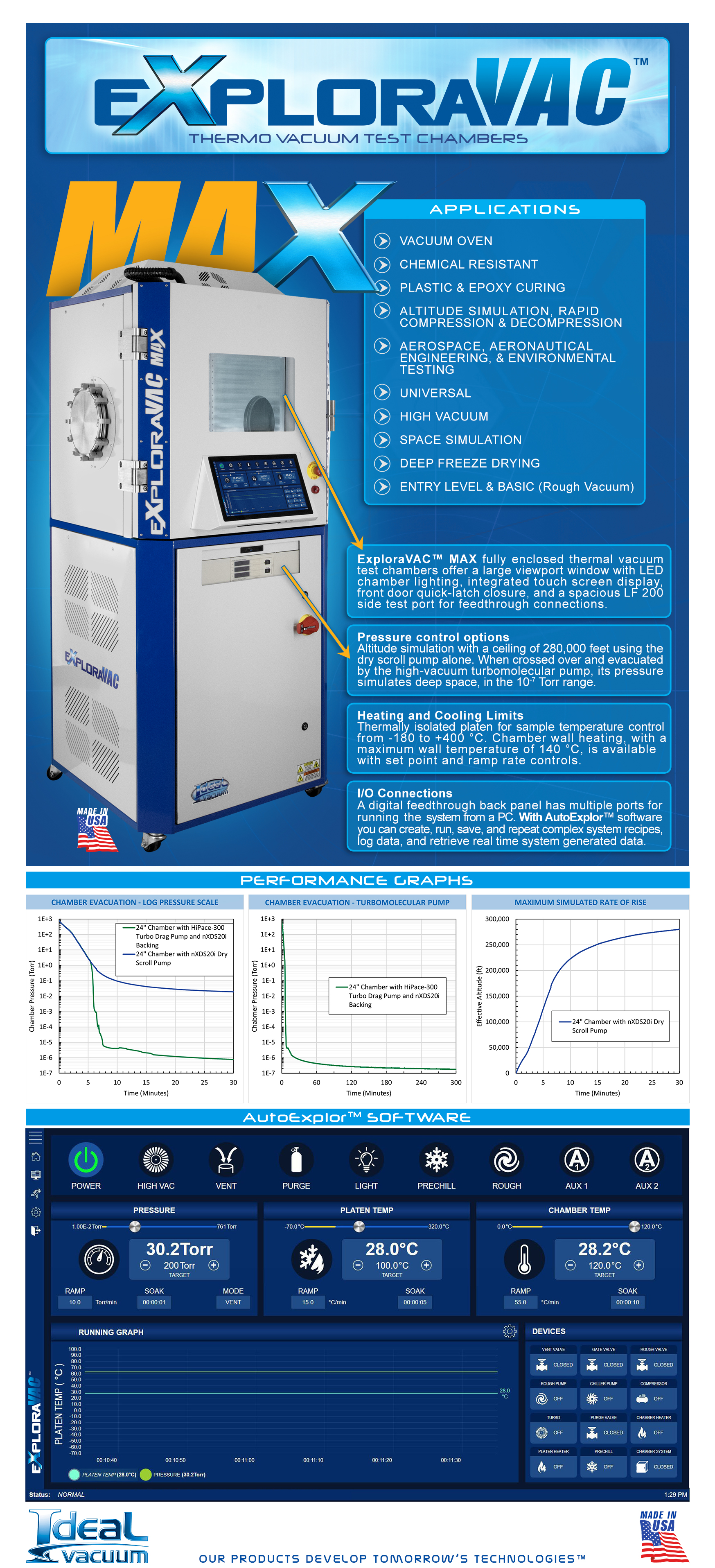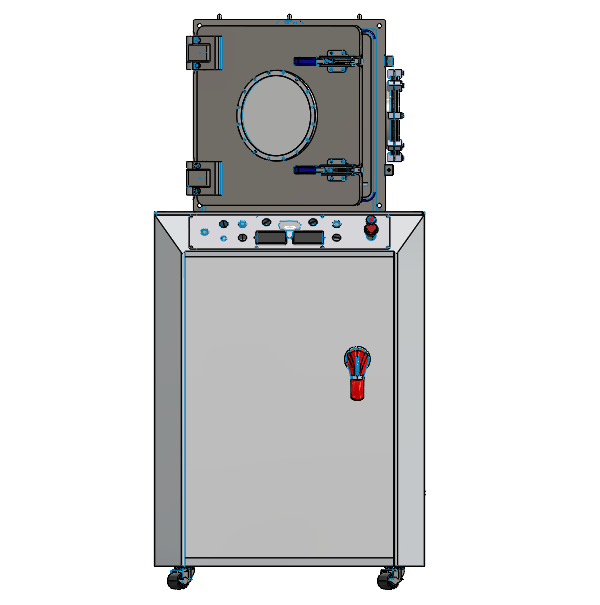This
ExploraVAC™ TVAC thermal vacuum test chamber is our Deep Freeze-Drying process system model. This is a fully integrated, turnkey, rough vacuum system featuring a large 20 inch cube welded stainless-steel vacuum chamber, a hinged stainless steel door with viewport, and a volume of 4.6 cubic feet. Designed with freeze-drying of sensitive materials in mind, this
ExploraVAC cooled sample vacuum system delivers sample temperature control from ambient temperature to -60 °C, accurate to ± 0.3 °C, on a 19” × 19” high-surface-area thermally isolated platen. It employs an Edwards nXDS20iC chemical resistant dry scroll vacuum pump to achieve pressures as low as 20 mTorr, which will quickly strip off solvent vapors. This Deep Freeze-Drying
ExploraVAC TVAC system weighs 848 lb., and requires single-phase, 208-240 VAC, 50/60 Hz, at 25 Amps.
See the performance graph PDF download below for all option's performance data.
ExploraVACDeep Freeze Drying System Configuration:
- 20 Inch Cube Welded Stainless Steel Chamber
- Stainless Steel Front Chamber Door with Viewport
- Heated and Cooled Platen
- Platen Temperature Range: -60°C to +225°C
- Edwards nXDS20ic Chemical Series Dry Scroll Vacuum Pump
- QTY2 LF-200 Side Ports (Allow for a variety of feedthroughs to be added from either side of the chamber)
The
ExploraVAC series of TVAC thermal vacuum chamber process and test instruments create precise environments empowering the operator with complete control over internal chamber pressure and temperature. They are built with innovation in mind. They allow for prototype device exploration in vacuum during the product research and development phase and for precise process control in small batch processing. These thermal vacuum test chamber instruments are designed to allow users to quickly tailor experiments to gather product analysis and diagnostics data as the product is subjected to the extreme stress factors of vacuum and temperature.
ExploraVAC TVAC thermal vacuum test chambers are completely configurable with many available system options (see product configurator above).
ExploraVAC System Configuration Options:
- Roughing Pump (dry scroll or dry multi-stage roots, various speeds)
- High Vacuum (various speeds)
- Full Vacuum Pressure Control
- Heated and Cooled Platen
- Chamber Wall Heating
- Integrated Chamber Lighting
- Closed-Loop Refrigerated or LN2Cryogenic Cooling System
- Automated Software Control
- Remote Control Operation
- Purge Ports, Chamber Shelving, and Much More
A large selection of vacuum chambers is available for
ExploraVAC, including welded stainless steel chambers with (internal) cubic sizes (12, 16, 20, or 24 inch) or Ideal Vacuum Cube™ modular chambers with (internal) cubic sizes (9, 12, or 24 inch). Chambers can be configured with aluminum or stainless steel doors, with or without viewports.
The
ExploraVAC TVAC system cabinet has a conveniently angled front panel control surface with colored LED pushbutton interface which controls all chamber functions. PID controllers and gauges are installed as required for user selected options. A PLC manages system functions including pump and valve sequencing for efficient pump down cycles and safety interlocks for preventing equipment damage. The front-accessible, built-in NEMA style enclosure houses the electronics needed for system operation.
A spacious LF-200 side port is available for user-selected or designed accessories, such as an electronic feedthrough for device monitoring or shock testing, an infrared lamp array for radiant heating or temperature differential tests, or an ultraviolet lamp array for ionizing radiation tests. This system could be customized to obtain any desired rate of rise by adding additional vacuum pumps mounted outside the cabinet.
The back of the cabinet holds a bulkhead feedthrough panel for chamber venting, pump exhaust, and the purge gas option. A digital feedthrough back panel has multiple ports including a DB9 connector for running the system remotely from a workstation or laptop running Microsoft Windows10 or 11 with our
AutoExplor™ software.
The (non-expiring) basic version of
AutoExplor (P1012102) allows a user to manually control devices while protecting the system.
AutoExplor properly sequences pumps and automatically operates the correct valves for a given request. The user can program pressure and temperature setpoints, ramp rates, soak times, and venting (if the system is equipped with those hardware options). The software provides real-time graphical data streaming so the user can visualize system behavior.
AutoExplor maintains an internal preventive maintenance schedule and notifies the user when system service is due. For example, it notifies when scroll pump tip-seal replacements are needed and when sensor calibration is due. This helps keep the system at peak operating performance. It also provides fault and error messages along with specific troubleshooting information in the case of a device failure so that the issue can be corrected as soon as possible.
The premium version of
AutoExplor (P1012100) includes all the features of the basic software package (above) and adds automated recipe control, data logging, and log export capabilities. Complex test recipes can be created as a step-by-step process, where each step can control the on/off state, setpoints, and ramp rates of multiple devices. One or multiple end conditions for each recipe step may be set using logical operators. The premium version allows the user to quickly generate environmental TVAC test reports from recipe data log files. Logs can be reviewed to ensure targeted process parameters are achieved. The premium version also includes
AutoExplor IP Client, which gives the software the ability to be used as a host that can manage multiple external network clients, and
AutoExplor API (application programming interface), which allows a scientist or programmer to integrate an
ExploraVac instrument into their existing software test suite without using
AutoExplor’s software interface. The premium version must be renewed annually or it reverts to the basic version.
The
ExploraVAC series of TVAC pressure and temperature-controlled test chambers are a perfect solution for many product testing requirements.
Sample Applications
- Environmental Testing Chamber
- Altitude Test Chamber
- Space Simulation Test Chamber
- Thermal Shock Chamber
- Aerospace & Aeronautical Engineering Test Chamber
- High Altitude Flight Component Testing
- Vacuum Oven
- Vacuum Freeze Drying
- Plastic & Epoxy Curing & Outgassing
About Vacuum Freeze-Drying:
Freeze-drying, also called lyophilization or cryodesiccation, is the process of removing water and other liquids from a sample below the freezing point of the water or other liquid by sublimation. Because the sample is fully solid during the drying process, its shape and inner geometry can be maintained down to the cellular or microscopic level.
While home and commercial freeze dryers are most commonly associated with food preservation, laboratory freeze dryers are often used by the pharmaceutical industry to preserve medicines in a lightweight and highly soluble form or to preserve live viruses and bacteria cultures commonly used in vaccines. Freeze-drying is also used to prepare culture or tissue samples for water-free imaging and microscopy techniques, such as electron microscopy. Small particles, such as nanotubes, which cannot be removed from a liquid suspension by filtration or evaporation without undesirable aggregate formation can be purified by freeze-drying.
Most laboratory freeze dryers utilize a sample cooling compartment and a cold collector array to capture water and solvent vapors. This protects the vacuum pump from damage but also introduces a liability of incomplete drying if the collector becomes saturated. Ideal Vacuum’s
ExploraVAC Freeze Dryer TVAC thermal vacuum system avoids this liability by utilizing a chemical-resistant, oil-free dry scroll pump capable of producing pressures as low as 2 × 10
-2 Torr (3 × 10
-2 mBar) to allow continuous, collector-free, freeze-drying. For basic freeze-drying applications, the system has a high-surface-area, thermally isolated platen with cascade-refrigerated circulating coolant that operates at -70 °C. For more advanced applications, where annealing or secondary drying is required, the platen can be equipped with heaters which allow precise temperature control from -70 to 400 °C with ramp rate and setpoint control accurate to ± 0.3 °C.
The freeze-drying system can be further upgraded with a liquid nitrogen cooling system capable of achieving sample temperatures as low as -170 °C, turbomolecular pumping to achieve vacuum pressures as low as 1 × 10
-7 Torr for even faster freeze-drying, and liquid nitrogen cooled trapping to prevent highly corrosive or toxic gases from escaping the system.



![]() eDrawings Viewer For Windows
eDrawings Viewer For Windows![]() eDrawings Viewer For MAC.
eDrawings Viewer For MAC.